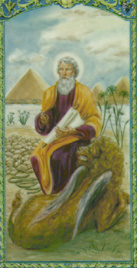 Hi readers, it seems you use Catholic Online a lot; that's great! It's a little awkward to ask, but we need your help. If you have already donated, we sincerely thank you. We're not salespeople, but we depend on donations averaging $14.76 and fewer than 1% of readers give. If you donate just $5.00, the price of your coffee, Catholic Online School could keep thriving. Thank you. Help Now >
Hi readers, it seems you use Catholic Online a lot; that's great! It's a little awkward to ask, but we need your help. If you have already donated, we sincerely thank you. We're not salespeople, but we depend on donations averaging $14.76 and fewer than 1% of readers give. If you donate just $5.00, the price of your coffee, Catholic Online School could keep thriving. Thank you. Help Now >
St. Paulinus, Archbishop of York
FREE Catholic Classes
Archbishop of York, died at Rochester, 10 October, 644. He was a Roman monk in St. Andrew's monastery at Rome, and was sent by St. Gregory the Great in 601, with St. Mellitus and others, to help St. Augustine and to carry the pallium to him. He laboured in Kent -- with the possible exception of a mission to East Anglia before 616 -- till 625, when he accompanied Ethelburga (Aethelburh), the sister of King Eadbald of Kent, when she went to the Northumbrian Court to marry King Edwin, then a pagan (see EDWIN, SAINT). Before leaving Kent, he was consecrated bishop by St. Justus, Archbishop of Canterbury. He was successful in converting Edwin and large numbers of his people, the king's baptism taking place on 12 April, 627. With the assistance of St. Edwin, he established his see at York and began to build a stone church there. His apostolic labours in instructing and baptizing the people of the north country were unceasing, and tradition perpetuates his ministry at Yeavering, Catterick Bridge, Dewsbury, Easingwold, Southwell, and elsewhere, while his own name is preserved in the village of Pallingsburn in Northumbria. On the defeat of St. Edwin in 633, Paulinus carried the queen and her children safely to Kent; and, as the heathen reaction under Penda made missionary work impossible in Northumbria, he devoted himself to the Diocese of Rochester, then vacant. It was after his flight that he received the pallium from Rome (634), sent to him as Archbishop of York. Though Anglican writers have disagreed among themselves as to whether he was justified in leaving his archbishopric, Catholic writers, following St. Bede, have held that he had no choice and was the best judge of what was advisable under the circumstances. St. Bede describes him as tall and thin, with a slightly stooping figure; he had black hair and an aquiline nose and was of venerable and awe-inspiring aspect. He was buried in his church at Rochester, and, on the rebuilding of the cathedral, his relics were translated by Archbishop Lanfranc to a silver shrine where they lay till the Reformation. His festival is observed in England on 10 Oct., the anniversary of his death.









 Daily Readings for Thursday, April 25, 2024
Daily Readings for Thursday, April 25, 2024 St. Mark: Saint of the Day for Thursday, April 25, 2024
St. Mark: Saint of the Day for Thursday, April 25, 2024 Prayer for Policemen: Prayer of the Day for Thursday, April 25, 2024
Prayer for Policemen: Prayer of the Day for Thursday, April 25, 2024

